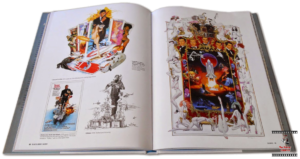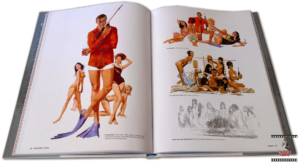Robert McGinnis, at age 91, may not be a household name, but his book covers, movie posters, and “McGinnis Girl” femme fatales sure are. Meet the man behind some of history’s most iconic movie posters, From Breakfast at Tiffany’s to James Bond.

Each month, the Men Who Are Thursday gather at a different member’s house amid the leafy streets of Greenwich, Connecticut. The men bring along brown-bag lunches; the host provides libations, hot soup, and dessert. The meetings, which started somewhere around 1969—no one’s exactly sure of the year—began in that ad hoc way such assemblages do, comprising an accomplished synod of artists and writers who, in the mid-20th century, had recast how America saw itself. At various points the brotherhood’s roster included co-founders David Burt, the sculptor, and Robert Miller Jones, a Grammy-winning art director for Columbia Records, along with novelist and screenwriter Herman Raucher, who wrote Summer of ‘42; sculptor Reuben Nakian, a contemporary of de Kooning’s; New Yorker cartoonist Charles Saxon; Gerald Green, one of the creators of the Today show; Alvin Moscow, a Richard Nixon speechwriter; and illustrator John Cullen Murphy, best known for the “Prince Valiant” comic strip.
The club borrowed its curious name from a 1908 G. K. Chesterton novel about a group of underground anarchists in London; to this day, there has been a longstanding tradition to admit a new member only when an old member dies. The lunches are marathon affairs. “The only thing you were assured of, going in, was that for the next three to four hours there was going to be wit—real wit, the kind you weren’t going to find anywhere else,” recalled cartoonist Jerry Dumas, 86, who wrote gags for comic strips like “Beetle Bailey.” Cohort Roy Rowan, 96, a correspondent for Time, Life, and Fortune, would remark in July, “We have what we call ‘Show and Tell’ [of our current projects]—very little ‘show,’ but a lot of bullshit. The whole group is reverting to childhood, really.” (Both Dumas and Rowan passed away, sadly, in late 2016.)
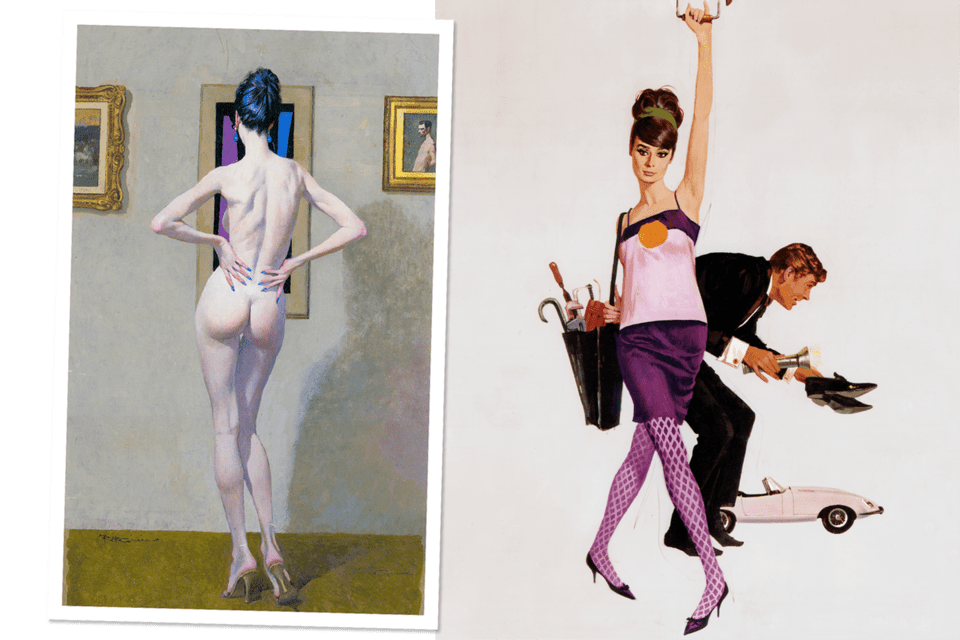
Image: Courtesy of Robert McGinnis.
Indeed, most of the inaugural Men Who Are Thursday have taken their leave. But their spirit and artistic genius endure, best personified in the crew’s quietest member: Robert McGinnis. “[All] are immensely charming, funny, lively men—livelier than a lot of 20- and 30-year-olds I’ve been around,” says screenwriter Jon Connolly, of boomer age, unlike his lunch companions. “A lot of guys had serious success but were very loath to advertise themselves. And Bob McGinnis is the most extreme. I mean, he is almost pathologically modest. He has no idea how good he was—how good he still is.”
Much of the public doesn’t know Robert McGinnis. But he is one of the most prolific and influential midcentury commercial artists, and his imprimatur on American illustration literally speaks volumes. During the swinging heydey of graphic design, his 1,400-plus paperback covers, along with his movie posters and magazine work, embodied and influenced pop culture’s loose, liberated visual style. And in the past decade, that cool McGinnis aesthetic has roared back into vogue as everyone from advertising executives to interior designers re-discovers its magic. “If you look at his book covers,” says Brad Bird, the director of Pixar’s The Incredibles, who hired McGinnis to produce a poster for the film, “they’re very much trying to convey and entice: ‘This is going to be fun.’ It doesn’t have pretention of being deep art.”
Last year, best-selling author Neil Gaiman conscripted McGinnis to illustrate the covers of his reissued novels, having been a McGinnis acolyte since his boyhood, when he would scour South London bookshops in search of import softcovers bearing McGinnis art. The covers of the new Gaiman paperbacks—one featuring sultry beauties, another an otherworldly Merlin character—are “a homage to Robert McGinnis,” Gaiman asserts, “by Robert McGinnis.”
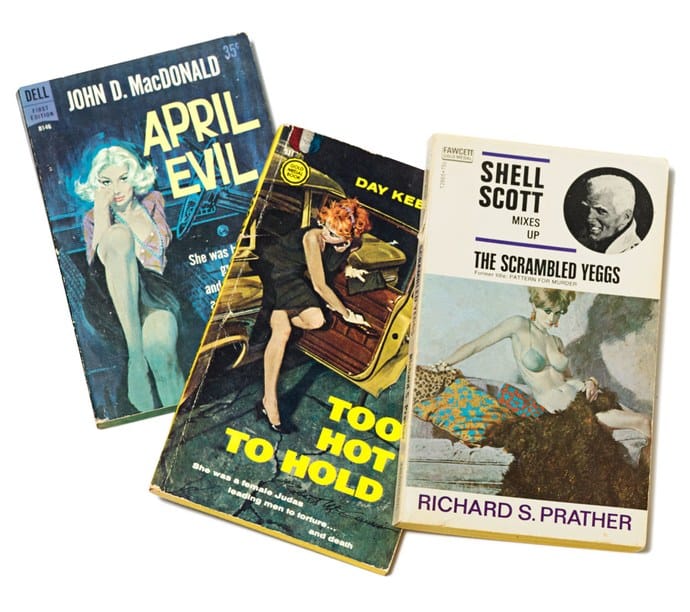
Image: Courtesy of Robert McGinnis.
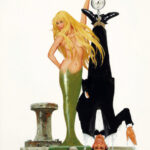
Photo: Courtesy of Robert McGinnis.
The artist is now 91. He paints every day inside his musty studio, located on the second floor of a nondescript office building in Old Greenwich. His hair is a shiny silver-white, his hands veined and weathered. Two bushy brows hood his eyes, lending him an eccentric air that doesn’t quite suit him. He is an old man and he knows it. He also knows he’s blessed. “I don’t know what I would do,” he says plainly, “if I ever stopped painting.”

Photo: Courtesy of Robert McGinnis.
We are fortunate that we have yet to find out. In the pantheon of movie posters, his are some of the most iconic: Audrey Hepburn and her cigarette holder in Breakfast at Tiffany’s; a bikini-clad Jane Fonda evading a fiery rocket in Barbarella; a stunning 1970 pastiche (pistols, Afros, and a gold Rolls) for one of Hollywood’s first big-budget African-American features, Cotton Comes to Harlem. But nowhere was McGinnis’s genius more prominently on display than in his posters for the James Bond films, sensual collages that effortlessly summoned the martini urbanity of Britain’s most famous spy. McGinnis, says longtime Bond producer Barbara Broccoli, “captures the wit, excitement, and adventure of Bond in a series of brushstrokes.” For Thunderball, a splashy three-poster series shows a smirking Sean Connery accompanied by a bevvy of dangerous curves.

Photo: Courtesy of Robert McGinnis.
Then there’s McGinnis’s book-cover oeuvre, which encompasses everything from potboiler (Judith Krantz’s 1979 riches-to-rags tale, Princess Daisy) to bodice ripper (Johanna Lindsey’s 1985 Tender Is the Storm, which displays a Colonial-era damsel fainting into the arms of a naked lover). And yet, it was through his illustrations of virile private eyes and their tempting sirens that McGinnis first made his mark, turning the pulp detective novel into a canvas for provocative simulacra for authors such as Erle Stanley Gardner, Elmore Leonard, and John D. MacDonald. For swashbuckling titles (The Careless Corpse, A Hearse of Another Color, Murder Me for Nickels, and Take a Murder, Darling), McGinnis crafted not just tableaux but entire narratives. In his design for Robert Terrall’s Kill Now, Pay Later, from 1960 (in which two guests at a high-society wedding turn up dead), a dirty-blonde in opera gloves and a dishevelled, celery-green dress holds a cigarette in one hand, an empty coupe in the other. Behind her, a greying Don Draper-esque investigator hoists a drink and a revolver. She looks as if she’s just heard someone outside the door. Stare at the image long enough and you can conjure an entire story without ever opening the book.

Photo: Courtesy of Robert McGinnis.
Like many of his generation, McGinnis discovered his vocation largely by accident. Raised in Ohio farm country, he was heavily influenced by the creativity of his uncle Ralph, a writer who glamorised rural life in the pages of the Farm Quarterly magazine and who was a close friend of the Pulitzer Prize-winning novelist Louis Bromfield, whose coterie included Sinclair Lewis, Edith Wharton, and Gertrude Stein. Bromfield hosted Humphrey Bogart’s wedding to Lauren Bacall, in 1945; Ralph was a groomsman. “He just made it sound like a wonderful way of life,” McGinnis says of his uncle’s world. “As a young boy I wanted to follow in that.”
After stints at the Walt Disney Studios, in L.A.—and the merchant marine during World War II— McGinnis ended up playing football for Ohio State, while studying fine art, and honed a talent for drawing. He married his college sweetheart, Ferne Mitchell (they’ve been together 68 years), and eventually moved east to try his hand at the illustration for a year to see if he could make a career of it. He stayed for the next 40, dashing off kicky ads for everything from furniture to women’s sleepwear. His colleagues included legends of commercial illustration, such as Bob Peak (who designed the movie posters for My Fair Lady and Apocalypse Now) and Frank McCarthy (The Ten Commandments and The Great Escape). When asked how his own graphic approach evolved during this period, McGinnis replies in typically understated fashion, “I didn’t think my style was as distinctive as theirs.”
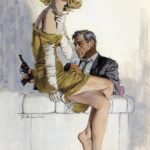
Photo: Courtesy of Robert McGinnis.
Oh, but it was. In Manhattan, in the late 1950s, a friend introduced McGinnis to an art director at Dell who eventually hired him to do covers (at $200 apiece) for four paperbacks, which had begun to dominate the market. The rest, as they say, is art history. Softcover books, McGinnis explains, “were intended to be read at home or on the train and then thrown away.” He had found his calling. “My illustration work went through the roof. I raised three kids on it. A lot of illustrators wouldn’t do them—they were considered cheap and low-grade. But I enjoyed doing them. I didn’t see anything demeaning about it.”

Photo: Courtesy of Robert McGinnis.
Over the next five decades, McGinnis would produce covers by the hundreds, in addition to lush landscapes and passion projects like his paintings of the American West. His illustrations would impact two generations of artists who followed him, recasting not only the pulpy swank of paperback jackets and film advertisements but even the movies themselves. When Aaron Osborne was hired as the production designer for the 2005 comedic-noir homage Kiss Kiss, Bang Bang (with an appropriately sardonic Robert Downey Jr. in the lead), Osborne says, “I walked into a very big white room and threw up about 40 covers from his paperbacks—all kinds. And we would refer to them as we location-scouted. They were kind of like a template for the entire movie.”
All of this was a revelation to McGinnis, who still—despite his induction into the Society of Illustrators Hall of Fame, the three coffee-table books that showcase his work, and the 2008 documentary about him (Robert McGinnis: Painting the Last Rose of Summer)—seems genuinely perplexed when anyone makes a fuss over his legacy. Indeed, he doesn’t seem to understand he even has one. As Don Smolen, the former art director for publicity at United Artists, once said, “You know, the only person that doesn’t believe Bob is a genius is Bob.”

Photo: Courtesy of Robert McGinnis.
Don’t look—it’s ghastly!,” McGinnis warns, flinging his arms in front of his weathered wood easel in his studio. He’s been working on a portrait of a local socialite. “I suppose it’s coming along,” he says, tilting back on his swivel chair in appraisal. “It’s just too harsh. I need to soften it.”
If there is one factor that distinguishes McGinnis’s work, it is his women. More specifically, “the McGinnis Woman,” the name that insiders apply to the femmes fatales who have adorned dozens of books about grizzled gumshoes such as Shell Scott and Al Wheeler. On the cover of Erle Stanley Gardner’s 1960 Some Women Won’t Wait, a blonde in a sloppy topknot, nude but for elegant jewellery, glares at the reader from a tall wicker chair. Gracing Charles Runyon’s Color Him Dead, from 1963: a topless brunette in an orange sarong looms in the doorway of a thatched hut; clearly, she will determine the fate of the bedraggled sot lying in the dirt.

Photo: Courtesy of Robert McGinnis.
The McGinnis Woman is a mix of Greek goddess and man-eating Ursula Andress. While today she might be interpreted as a sex object or adornment, she was conceived, in her day, to represent the empowered woman. In fact, the McGinnis Woman possesses a whirling narrative force all her own, a perfumed cyclone of sexuality, savvy, mystery, and danger. She also sells books—lots and lots of books. “The McGinnis Woman was impossibly tall, impossibly beautiful, slightly aloof, and unattainable,” in the words of Charles Ardai, the editor in chief of Hard Case Crime, a publisher of noir fiction, who still hires McGinnis to illustrate his covers. “When Bob was doing the Brett Halliday series, back in the late 50s and early 60s,” adds filmmaker Paul Jilbert, who directed the McGinnis documentary, “they were offshoots of the men’s magazines: the bare-chested men with the women behind them, cowering in the corner. What Bob did was to bring the women into the foreground—put them out in front of the guy, and made them much more powerful, sophisticated, intelligent. You just didn’t see that in other covers.”

Photo: Courtesy of Robert McGinnis.
McGinnis’s temptresses soon became his calling card. Using lithe, leggy models such as Shere Hite (who would gain fame as a sexologist and the author of the 1976 best-seller The Hite Report), McGinnis wielded his Russian-sable brushes to create a legion of bewitching Salomes. “I wish,” Raquel Welch once remarked wistfully, “I looked half as good as his painting of me.” That doesn’t mean everyone adored McGinnis’s highly stylised approach or the liberties he took to enhance his subjects. “A great movie poster will get everyone’s attention—and he certainly did that with the beautiful woman they now claim is me,” says Jane Seymour, who in 1973 played Bond girl Solitaire, alongside Roger Moore, in Live and Let Die. A sexed-up version of her character—a redhead, not a brunette, in a bikini (Seymour never wore one in the film)—appears in McGinnis’s eye-popping billboard. “I think it’s a great poster. But at the time I saw it I thought, It’s a shame I’m not on it. I thought I was in this movie.”
McGinnis insists he just wanted to paint women. Not molls, not dames. Instead, he combined “intelligence with the perfection of the pose or the figure. To me, it showed respect.” When Playboy made overtures to have him possibly succeed Alberto Vargas, creator of “the Vargas Girl,” McGinnis says he declined to even take the meeting. “I didn’t like what was going on there, with the bunny tails and the ridiculous way they treated women. Zaftig women, who always had orange-colored skin. They were not real.”
Instead, McGinnis drew his inspiration from the great fashion legends, from early supermodel Dorian Leigh (“Nobody ever looked like that”) to Stephanie Seymour. “All men are just victims,” he says, “hooked and helpless in the face of female beauty.”
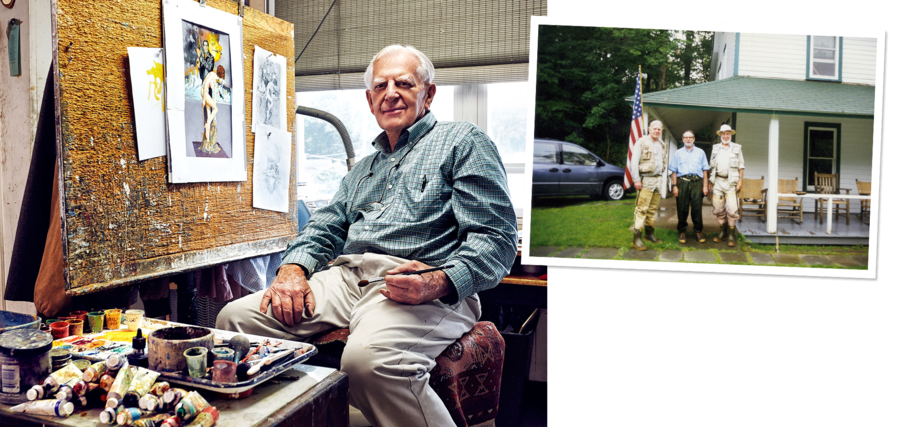
Inset, the artist at his studio, in Old Greenwich, Connecticut, 2016.
IMAGE (LEFT): Courtesy of Candice Forness; IMAGE (RIGHT): Courtesy of Robert McGinnis.
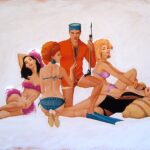
Photo: Courtesy of Robert McGinnis.
McGinnis is lucky in more ways than just longevity. Some of his work still exists in its original form, which has allowed him to license prints of many of his classic creations. His son, Kyle, acts as his de facto manager, selling the occasional sketch or canvas. Indeed, hundreds of devoted collectors now buy, sell, and trade McGinnis imagery. (In the art market, the value of McGinnis’s work varies wildly, depending on its condition, format, and what the image is. While prints go for as little as $150, and lithos for 10 times that much, original art can sell for four figures—$6,000 and up in certain venues—with some pieces rising beyond $15,000.)

Photo: Courtesy of Robert McGinnis.
But as fate would have it, he owns almost none of his movie-poster art, much of which was, tragically, tossed by the studios. There is some irony in the fact that, of all of McGinnis’s illustrations, his most famous is one he finds rather unremarkable: the now iconic 1961 poster for Blake Edwards’s film adaptation of Truman Capote’s Breakfast at Tiffany’s. It shows Audrey Hepburn—cat perched on her shoulder, two-foot-long cigarette holder protruding from her lips—looking mischievous, and glorious. “I never dreamed it would be the most printed thing in history,” McGinnis says with a shrug. “You see it everywhere”. Including Central Park, where some years ago McGinnis found himself strolling, only to come upon one of those kiosks that sell cheap poster art to passing tourists. McGinnis spotted a reproduction of his Hepburn drawing and nodded to the woman in the booth. “You know, I did that,” he told her. He lets out a rollicking belly laugh, remembering the moment. “She had this look on her face like ‘O.K., move along.’ ” He shakes his head. “I was waiting for her to ask the question.”. What question is that? “You wanna buy one?”.
Iconic Illustrations
Books
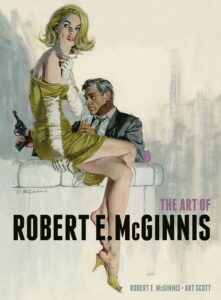 Released in 2014, the book The Art of Robert E McGinnis features 176 pages covering six decades of Robert E McGinnis fantastic artwork and features a fantastic in-depth interview with the man himself by the author Art Scott. The book includes all of Robert’s most iconic movie images, as well as other highlights from his career, including book cover illustrations, various magazines and newspaper covers, Western and contemporary landscapes, his personal paintings of nudes often referred to as the ‘McGinnis Women’ and other personal original works.
Released in 2014, the book The Art of Robert E McGinnis features 176 pages covering six decades of Robert E McGinnis fantastic artwork and features a fantastic in-depth interview with the man himself by the author Art Scott. The book includes all of Robert’s most iconic movie images, as well as other highlights from his career, including book cover illustrations, various magazines and newspaper covers, Western and contemporary landscapes, his personal paintings of nudes often referred to as the ‘McGinnis Women’ and other personal original works.
Throughout McGinnis shares his creative process, insights from his illustrious career and provides back stories to some of his pieces of works. He discusses in details the elaborate wraparound art that required meticulous research with extensive model shoots, his movie posters from titles such as Breakfast at Tiffanys, Diamonds Are Forever, Thunderball and several other Bonds that required countless iterations and his illustrations on Hard Case Crime covers.
Fans of Robert E McGinnis’ art will be delighted with this book. And those who don’t know who he is will be surprised by his stunning work.”
The art is reproduced in raw format without any other forms of typography or designs hanging over the images. The definitive collection of artbook by one of the world’s best illustrators; The Art of Robert E McGinnis is an absolute must-have for any movie buff and provides an unrivalled slice of both art and cinema history from a member of the Society of Illustrators Hall of Fame.
The Art of Robert E. McGinnis is one of those must haves, a book any movie or fine art fan will want to pick up to look through again and again.”
NOTE: Original article was written by Michael Callahan and featured in the April 2017 Edition of Vanity Fair magazine.
If you liked the website, found it useful and would like to help with its continued ad-free development, you can make a donation via PayPal. Small or large, it doesn’t matter, every little helps! We thank you for your continued support.















